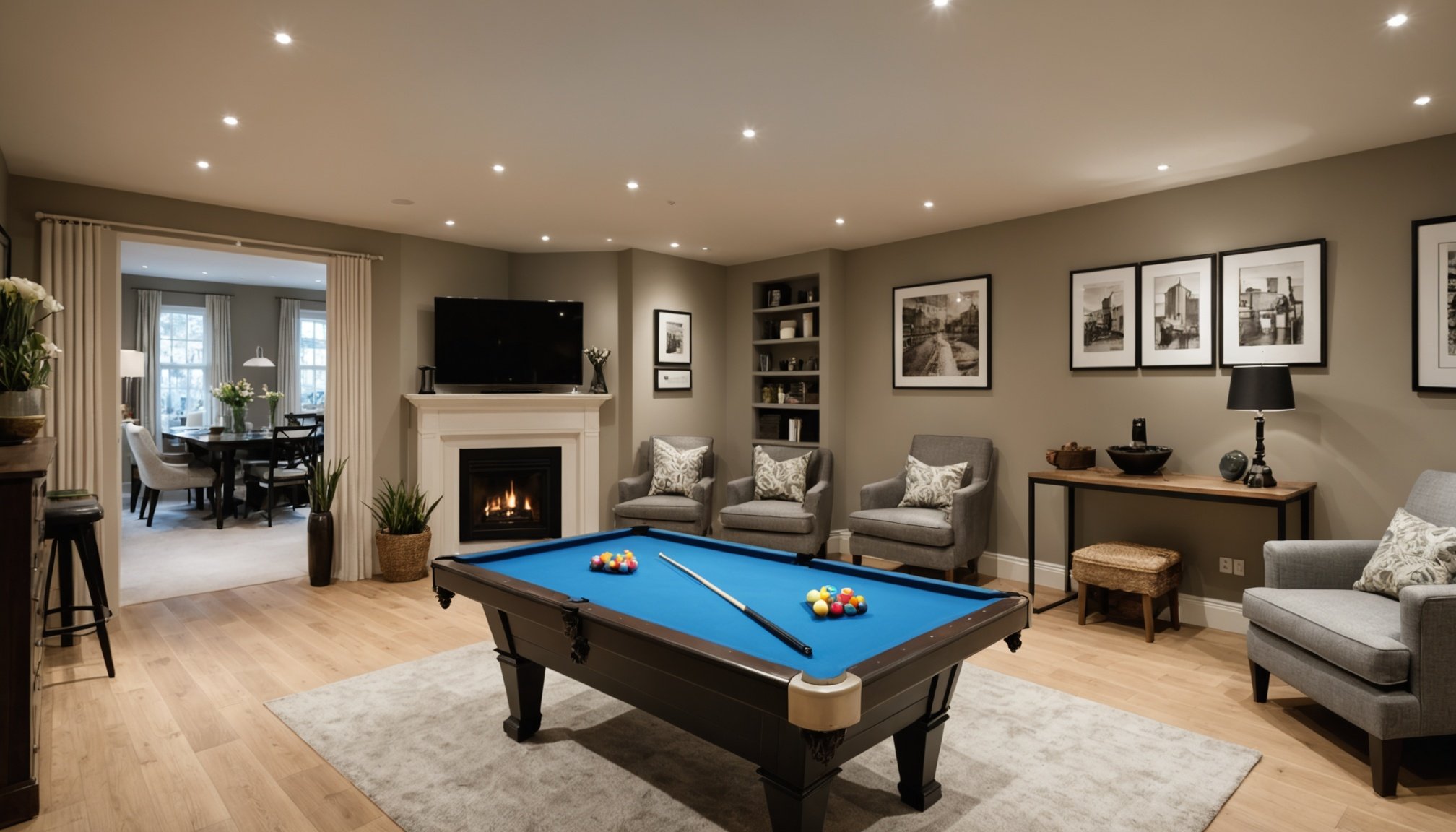Design Ideas for Basement Transformations
Transforming a basement into a stylish living space can greatly enhance the usability and value of a home. Popular design themes for basement transformations in the UK often revolve around creating cosy, multifunctional areas. For instance, modern minimalist styles are trending, emphasising simplicity and maximizing space without sacrificing elegance.
Incorporating natural light and ventilation is integral in these designs. Given that basements are often below ground level, innovative solutions like light wells or glass doors can help bring in sunlight. Moreover, installing smart ventilation systems ensures a fresh and comfortable environment, preventing issues like dampness and poor air quality.
This might interest you : Essential Insurance Considerations for UK Properties Operating as Airbnb Rentals
When selecting furniture and decor for these spaces, it’s crucial to consider the limitations of small spaces. Compact, multifunctional furniture, such as sofa beds or extendable tables, offer flexibility without overcrowding. Opting for light-coloured walls and reflective surfaces can create an illusion of space and brightness.
Finally, UK home decor trends lean towards sustainable materials and eco-friendly choices, marrying functional design with environmental consciousness. This approach not only contributes to a stylish atmosphere but also aligns with contemporary lifestyle preferences, adding a personal touch to each basement renovation project.
Additional reading : Unlocking brownfield potential: an essential blueprint for uk property developers to tackle redevelopment challenges
Understanding Regulations and Building Codes
Navigating the maze of building regulations for basement renovations is crucial for ensuring both legality and safety. In the UK, transforming a basement into a living space requires careful attention to these regulations to avoid future complications.
UK planning permission is often a necessary step, particularly if structural changes are involved, such as altering load-bearing walls or extending the property. It’s essential to consult local authorities to determine whether your project needs permission, as non-compliance can result in hefty fines or mandatory removal of alterations.
Fire safety regulations are another critical aspect. Basements must have reliable escape routes in case of fire, which often means incorporating specific window sizes or creating external exits. Additionally, understanding ventilation requirements is vital, as proper air circulation is necessary to prevent mould and ensure a healthy living environment.
These basement renovation laws are designed to protect homeowners and enhance the longevity and safety of the modification. By adhering to these regulations, you not only safeguard your investment but also contribute to a secure and sustainable living space, assuring peace of mind throughout the renovation process. Proper compliance underscores the importance of thorough planning and expert consultation.
Budgeting for Your Basement Renovation
Establishing a comprehensive financial plan is pivotal when considering a basement renovation. Basement renovation costs in the UK vary widely based on the scope and nature of each project. On average, costs may range from £800 to £1,500 per square metre. These figures can increase when adding features like advanced ventilation or high-end finishes.
Developing a realistic budget ensures a smoother renovation process. Begin by assessing the overall goals of your project, and then allocate costs to different areas such as structure, utilities, and interior design. It’s beneficial to set aside a contingency fund, typically around 10-15% of the total budget, to address any unforeseen expenses.
For those seeking cost-effective renovations, consider strategies like opting for durable yet affordable materials and reclaiming or repurposing existing furniture. DIY approaches for simpler tasks can further reduce expenses; however, always hire professionals for critical jobs, such as plumbing or electrical work, to ensure safety and compliance with regulations.
Effective financial planning not only keeps the project on track but also maximizes the value added to your home. By carefully balancing expenditure with quality, homeowners can achieve a stylish and functional basement space within their financial means.
Potential Uses for Basement Spaces
Transforming your basement into a multi-purpose space can significantly enhance your home’s functionality. One popular option is creating a home office. Given the rise of remote work, having a dedicated workspace is invaluable. Design your office with ergonomic furniture, sufficient lighting, and reliable internet connections to boost productivity.
Alternatively, consider setting up a gym or fitness area. This transformation promotes health and wellness right in the comfort of your home. Equip the space with essential gym equipment and use rubber flooring for a safe workout environment. Install mirrors and improve ventilation to mimic a commercial gym’s ambiance.
Realising a basement’s potential doesn’t stop there. Designing guest rooms or rental spaces can also be a lucrative choice. To convert a basement into welcoming accommodation, focus on comfort: install cosy furnishings, warm lighting, and ensure ample storage space. For rental purposes, add amenities like a small kitchenette or private bathroom to increase appeal.
These diverse uses make multi-purpose basements a smart investment. They add both practical value and personal enjoyment to your living environment, providing tailored spaces to suit your lifestyle needs and preferences.
Case Studies and Testimonials from UK Homeowners
Exploring homeowner testimonials provides insightful glimpses into successful basement projects across the UK. Such examples serve as both inspiration and guidance for those considering similar transformations.
In one instance, a couple from Birmingham transformed their basement into a contemporary home office. They praised the use of multifunctional furniture and smart lighting systems that boosted productivity while maintaining aesthetic appeal. According to their testimonial, the key was integrating ergonomic furniture and ensuring a clutter-free environment.
Another inspiring project includes a family in Manchester who converted their basement into a versatile multi-purpose space. This renovation accommodated a home cinema, a compact gym, and a play area for children. Their clever use of retractable screens and fold-away furniture maximized utility without sacrificing style.
Lastly, a homeowner in Surrey shared their experience of turning their damp basement into a welcoming guest suite, complete with a small ensuite bathroom. They highlighted the essential role of proper ventilation and moisture control in achieving a comfortable living area.
These stories illustrate diverse possibilities for basement renovations, offering key takeaways on creativity, innovative design solutions, and practical challenges faced during the process. Such testimonials underscore the importance of thorough planning and the value of personalising spaces to individual needs.











